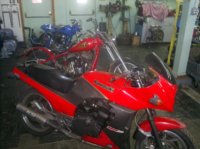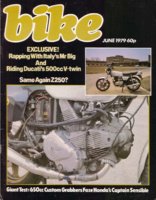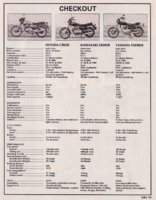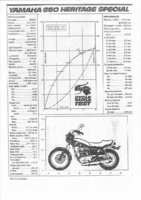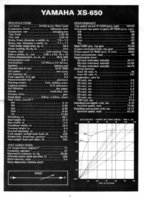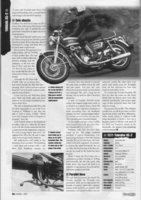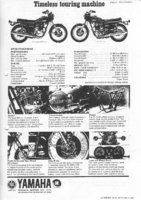Top speed wasn't why I bought one new. It was the bike's presentation......I had to edit a bit for length.
Sunday, September 2, 200
The alternative: The Yamaha XS650.
From Bikernet. and originaly reprinted from "Cycle World" magazine March, 1979
"A lot has been said about tradition, about how the Yamaha XS650 sounds and feels like the British vertical Twins that dominated motorcycling in the 1950s and 1960s. Present-day cynics weaned on multi-cylinder bikes say that the Yamaha vibrates and runs rough. Compared to a Four or Six, that's right. But within the context of being a vertical Twin without dynamic balancers to offset the natural vibration of two large pistons pumping up and down, the Yamaha is remarkably smooth. Not only is the Yamaha far smoother than the old British Twins, but it is in every way a modern motorcycle.
It's the sound, as much as anything. Hit the starter button and the engine growls to life with a subdued roar, then settles into the loping gait of a large vertical Twin, the sound of an even series of cylinder explosions separated by flashes of silence.
It doesn't purr or whine or mumble. It idles, the handlebars and front end moving with the engine pulsations, trembling in anticipation of the ride to come. It sounds like a motorcycle, not a two-wheeled Porsche; and feels like a motorcycle, not an electric golf cart. You can hear and feel the source of power, gasoline explosions encased in iron and aluminum and steel. The rider, like it or not, is involved in the reality of the machinery.
That reality starts with the 653cc SOHC engine, which is slightly oversquare with bore and stroke of 75 x 74mm. The 360° crankshaft uses three roller bearings and a ball bearing, and drives the clutch via spur-cut gear. Rod big ends have needle roller bearings, while bushings are used in the small ends. The camshaft rides on two pairs of single-row ball bearings and is driven at half crankshaft speed via a roller cam chain. Combination cam follower/rocker arms open the valves: valve lash is maintained by conventional adjustable tappets. Ignition points are driven off one side of the camshaft. Transmission is five speed. Two 38mm Mikuni constant vacuum carburetors feed the beast. The rider has his choice of starting methods, kick or electric. Weight with a half-tank of fuel is 481 lb.
Because the Yamaha 650 is a traditional sort of engine there has long been talk of its heritage.
The Yamaha's line of descent actually reaches back to 1955 and the Hosk SOHC 500 Twin, which in its day was the only Japanese motorcycle capable of running with the fast British machines of the period. Along its path into the motorcycle business Yamaha acquired Hosk, so that's where they got the basics for the XS650, introduced in 1970.
The days when Twins were the fastest motorcycles are long past, but the XS650 turns in a respectable performance in class, with a standing-start quarter-mile of 13.86 sec. at 96.05 mph. That elapsed time is the same as the best recorded by the 1978 Triumph Bonneville 750, which turned 13.86 sec.; and better than the 14.14 sec. turned by the Kawasaki DOHC KZ750 Twin. The XS650 is also quicker than the Harley-Davidson 1000cc V-twin Sportster (14.22 sec.) and the 1979 BMW R65 flat-Twin (14.31 sec.).
Taken within the context of a motorcycle marketplace dominated by multi-cylinder motorcycles, the XS650's performance doesn't fare as well. It has it's advantages, though.
Besides being narrower than competing multis, the Yamaha also carries its engine weight lower. That lower center of gravity means that the XS650 can be flicked from side to side and can change direction more easily and quickly than the Fours. It means that the Yamaha feels lighter in traffic and at speed, and steers faster. The difference a lower center of gravity makes shows up dramatically when the rider is cutting through traffic, a time when the ability to make quick lane changes is desirable. The narrowness of the engine also makes riding between lanes of a traffic jam (in states where that's legal) less nerve-wracking-the Yamaha can fit through a tighter space with more clearance.
The XS650 has a broad powerband and runs easily at low rpm. Starting at 2000 rpm and shifting up at 4000 rpm feels natural and is enough to run away from traffic. Below 4000 rpm. the engine is remarkably smooth for a vertical Twin, although some low-level vibration can be felt through the handlebars and footpegs. Even so, the mirror image is reasonably clear. The bike makes its best power above 5000 rpm, but low-frequency vibration increases dramatically above that engine speed and can be felt through the seat as well as through the rubber-mounted bars and pegs. In spite of the fact that the KZ750 Twin has dynamic balancers to theoretically reduce engine vibration, the XS650 actually vibrates less at higher rpm than the Kawasaki. The Yamaha is also smoother than Triumphs we've ridden.
An indicated 65 mph requires about 4200 rpm, and at that engine speed the machine is smooth enough that our riders could stand a long day in the saddle without discomfort.
A long day wouldn't make the rider's arm or wrist sore from holding the twist grip open, because the Yamaha doesn't have excessively strong carburetor return springs. Besides making life a little easier for the rider's throttle arm, the butterfly-throttle, vacuum-piston Mikunis also have a lot to do with the Yamaha's excellent gas mileage. The bike averaged 51.4 mpg on the Cycle World test loop, a mixture of city and highway riding and did marginally better (51.6 mpg) in constant-speed high- way riding; That means an XS650 ridden at an indicated 65 or 70 mph on the highway can travel about 200 miles before the fuel tank runs dry. Even during the hardest highway running, the Yamaha delivered 46.8 mpg, a figure some multis couldn't reach at a constant 40 mph.
Accumulated transmission gear engagement dog tolerances combine with the low-speed carburetion inaccuracies to cause the Yamaha to jerk back and forth as throttle is applied or released. The trait can be compensated for by careful use of the throttle and clutch, but idling smoothly along-in gear and with the clutch out isn't possible.
The transmission which has proven itself during the XS650's lifetime requires a firm foot on the shift lever. It doesn't clunk, but is a bit hesitant to slide from gear to gear. The transmission works, but won't earn praise for effortless or slick shifting.
The bike starts easily even on cold mornings if the correct procedure is followed. The "choke"lever actually activates enrichening circuits in the carburetors. With the "choke"on and the throttle left closed, the XS650 starts quickly. But the motorcycle won't start if the throttle is opened at all.
By removing the passenger grab strap and substituting a grab rail behind the seat, Yamaha engineers improved the XS650's seat a great deal. Seat grab straps have a nasty habit of being positioned just where the solo rider wants to sit, making the seat less comfortable at best and often numbing the rider's butt during long rides. The 1979 version of the 650, thanks to that simple change and also the suspension, is the most comfortable XS650 so far. Fork compliance is good. With a 140-lb. rider and no baggage, the rear shocks are too stiff, but that's a matter of personal preference. Suspension action on both large and small bumps is above average. The only chassis flaw encountered during highway testing was a tendency for the Bridgestone Super Speed tires to follow freeway rain grooves and produce a slight front end oscillation noticeable through the handlebars.
In sporting use the XS650 acquitted itself well, largely because of its low center of gravity and ability to turn quickly without requiring a lot of rider force. Instead of having to lift the bike up - as is the case with many street bikes - from one side and throw it down on the other side to make fast left-right transitions (as in ess curves) the rider can accomplish the same thing with far less effort. Simply put, the Yamaha Twin responds to rider input quickly and easily. Only the fastest, quickest - entry turns produced the barest hint of a wallow with the shocks at the lowest preload setting. At the highest speeds it is capable of attaining, the XS650 handles almost perfectly. Ground clearance is excellent, and only the hardest riding is likely to drag parts. On the left side, the side stand scrapes. On the right side the footpeg and muffler bracket mount bolt will scrape, but only at the point at which the tires slide and lose traction. When the bracket bolt touches down, the rider better be ready to try a flat-track-style slide or else abandon ship. It takes an extreme lean angle to get into that kind of trouble.
The single front disc feels strong and is controllable, but we had problems keeping the rear drum from locking during panic stops (for braking distance tests). Rear brake control under normal conditions wasn't a problem. Front brake effectiveness is limited by tire adhesion - the brake can deliver more stopping power than available tire traction can handle. Finding the point of maximum deceleration while avoiding lock-up is not difficult.
The XS650 really isn't very much like the Triumphs and BSAs of old. It's a modern motorcycle, refined and honed and civilized, and it does what it does very well."


 .
.